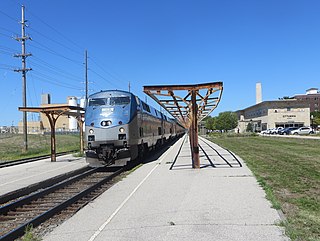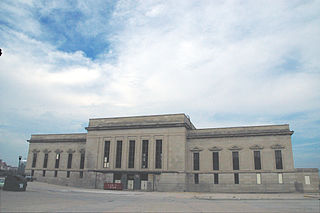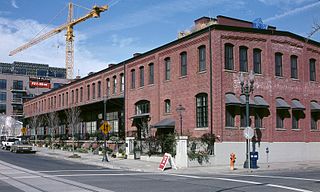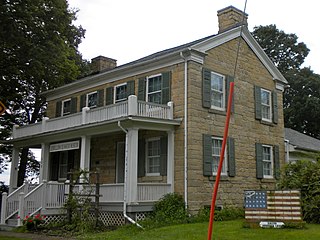
The Eads Bridge is a combined road and railway bridge over the Mississippi River connecting the cities of St. Louis, Missouri, and East St. Louis, Illinois. It is located on the St. Louis riverfront between Laclede's Landing to the north, and the grounds of the Gateway Arch to the south. The bridge is named for its designer and builder, James Buchanan Eads. Work on the bridge began in 1867, and it was completed in 1874. The Eads Bridge was the first bridge across the Mississippi south of the Missouri River. Earlier bridges were located north of the Missouri, where the Mississippi is smaller. None of the earlier bridges survived, which means that the Eads Bridge is also the oldest bridge on the river.

Omaha station, located at 1001 South 10th Street in downtown Omaha, Nebraska, is a historically and culturally significant landmark, and is listed on the National Register of Historic Places, which is currently used as the studio facility for Omaha's ABC affiliate, television station KETV. When it was opened in 1898, this Italianate style building, designed by Thomas Rogers Kimball, was hailed by newspapers around the world for its grand architecture and accommodations. The station is a contributing property to the Omaha Rail and Commerce Historic District, and sits southeast of the Old Market, and immediately north of Little Italy.

Bellows Falls station is an Amtrak intercity rail station located in the Bellows Falls village of Rockingham, Vermont, United States. The station is served by the single daily round trip of the Washington, D.C.–St. Albans Vermonter. It has a single side platform adjacent to the single track of the New England Central Railroad mainline.

Rouses Point station is an Amtrak intercity train station in Rouses Point, New York, served by the single daily round trip of the Adirondack. The station building is a former Delaware and Hudson Railway constructed in 1889, with a one low-level side platform on the east side of the track. It was added to the National Register of Historic Places in 2005 as Rouses Point Railroad Station.

Winona station is an Amtrak train station in Winona, Minnesota, United States. It is served by the daily round trips of the Borealis and Empire Builder. The station building was listed on the National Register of Historic Places in 2013 as the Chicago, Milwaukee & St. Paul Railway Station. The station is typically the second-busiest Amtrak station in Minnesota.

Ottumwa station is an Amtrak intercity train station in Ottumwa, Iowa, United States. The station was originally built by the Chicago, Burlington and Quincy Railroad, and has been listed as Burlington Depot by the National Register of Historic Places since November 26, 2008. It became a contributing property in the Historic Railroad District in 2011.

Baton Rouge station is a historic train station located at 100 South River Road in downtown Baton Rouge, Louisiana. It was built for the Yazoo and Mississippi Valley Railroad which got absorbed by the Illinois Central Railroad. The station was a stop on the Y&MV main line between Memphis, Tennessee and New Orleans, Louisiana. The building now houses the Louisiana Art and Science Museum.

Railroads in Omaha, Nebraska, have been integral to the growth and development of the city, the state of Nebraska, the Western United States and the entire United States. The convergence of many railroad forces upon the city was by happenstance and synergy, as none of the Omaha leaders had a comprehensive strategy for bringing railroads to the city.

The Atchison, Topeka and Santa Fe Passenger and Freight Complex is a nationally recognized historic district located in Fort Madison, Iowa, United States. It was listed on the National Register of Historic Places in 1992. At the time of its nomination it contained three resources, all of which are contributing buildings. The buildings were constructed over a 24-year time period, and reflect the styles that were popular when they were built. The facility currently houses a local history museum, and after renovations a portion of it was converted back to a passenger train depot for Amtrak, which opened on December 15, 2021.

The Burlington Headquarters Building, also called Burlington Place, is located at 1004 Farnam Street in Downtown Omaha, Nebraska. This four-story brick building was originally designed by Alfred R. Dufrene and built in 1879 next to Jobbers Canyon. It was redesigned by noted Omaha architect Thomas R. Kimball in 1899, and vacated by the railroad in 1966. The building was listed on the National Register of Historic Places in 1974, designated an Omaha Landmark in 1978, and rehabilitated in 1983. Today it is office space.

The St. Louis County Depot is a historic railroad station in Duluth, Minnesota, United States. It was built as a union station in 1892, serving seven railroads at its peak. Rail service ceased in 1969 and the building was threatened with demolition until it reopened in 1973 as St. Louis County Heritage & Arts Center . Train service also resumed from 1974 to 1985, by Amtrak.

The Chicago, Rock Island and Pacific Railroad Passenger Station is a historic building located in Iowa City, Iowa, United States. Built in 1898 for passenger use, it was the second depot in the city. The first one was built by the Mississippi and Missouri Railroad, a predecessor of the Chicago, Rock Island and Pacific Railroad (CRI&P), in 1855. This one was built through the efforts of Harry Breene, the local Rock Island agent. W.K. McFarlin, CRI&P's superintendent of maintenance and construction oversaw the building's construction. Architecturally, it is a combination of the Richardsonian Romanesque and Victorian Romanesque. The depot was built to similar designs of stations in Ottawa, Illinois, and Council Bluffs, Iowa.

The Burlington, Cedar Rapids and Northern Railway (BCR&N) was a railroad that operated in the United States from 1876 to 1903. It was formed to take over the operations of the bankrupt Burlington, Cedar Rapids and Minnesota Railway, which was, in turn, the result of merging several predecessor lines, the construction of which began in 1869. The corporate headquarters were in Cedar Rapids, Iowa, and it had operations in Iowa and in Minnesota. It was succeeded by the Chicago, Rock Island and Pacific Railway.

Union Station, also known as Union Station and Burlington Freight House, is located along the riverfront in downtown Davenport, Iowa, United States. It is listed on the National Register of Historic Places. The buildings are in a section of downtown with several historic structures. Across Ripley Street to the west is the Chicago, Milwaukee, St. Paul and Pacific Freight House, and to the east across Harrison Street is the Dillon Memorial. On River Drive northwest from the Burlington Freight House is The Linograph Company Building. Across Beiderbecke Drive to the south are the W.D. Petersen Memorial Music Pavilion and the Mississippi River.

The North Bank Depot Buildings, in central Portland, Oregon, United States, are a pair of buildings formerly used as a freight warehouse and passenger terminal for the Spokane, Portland and Seattle Railway (SP&S). Formed in 1905, the SP&S was commonly known as the North Bank Road during the period in which these buildings were in use. The Portland buildings' passenger facilities were also used by the Oregon Electric Railway after that railway was acquired by the SP&S. Located in what is now known as the Pearl District, the buildings were listed on the National Register of Historic Places in 1996. They were in use by the SP&S and its successor, Burlington Northern Railroad, from 1908 until the 1980s. Only the east building was used as a passenger station, and this usage lasted from 1908 until 1931.

Union Station is a building in Houston, Texas, in the United States. Dedicated on March 2, 1911, and formerly a hub of rail transportation, the building now serves as a cornerstone for Minute Maid Park. It is listed on the National Register of Historic Places, and has since been superseded by Houston's Amtrak station.

The Burlington, Cedar Rapids & Northern Freight House, also known as the Rock Island Freight House, is a historic building located in Burlington, Iowa, United States. It was listed on the National Register of Historic Places in 1983.

Keokuk Union Depot is a historic train station on the west bank of the Mississippi River near downtown Keokuk, Iowa, United States. It was built from 1890 to 1891, and it was listed on the National Register of Historic Places in 2013.

The Henderson Lewelling House, also known as the Lewelling Quaker Museum, is a historic building located in Salem, Iowa, United States. Henderson Luelling and his wife Elizabeth were among the first settlers in the Quaker community of Salem in 1837. They moved here from Henry County, Indiana, and Henderson moved his fruit tree nursery with him. This was Iowa's first commercial nursery. Henderson built this two-story stone house with Greek Revival details in 1843. The Lewellings were abolitionists associated with the Society of Anti-Slavery Friends, and his home is thought to have been a stop on the Underground Railroad. The family left Salem for Oregon in 1847, taking the nursery with them.

The Davenport Downtown Commercial Historic District is a nationally recognized historic district located in the central business district of Davenport, Iowa, United States. It was listed on the National Register of Historic Places in 2020. At the time of its nomination it consisted of 43 resources, which included 33 contributing buildings, one contributing structure, and nine non-contributing buildings. In addition, the district also contains 33 buildings that are individually listed on the National Register. This historic district is bordered by four other districts: the Crescent Warehouse Historic District and the Davenport Motor Row and Industrial Historic District on the east, the Hamburg Historic District to the northwest, and the West Third Street Historic District on the west.























